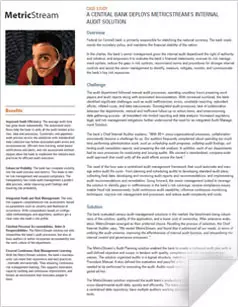
AI-First Connected GRC
Drive a Connected GRC Program for Improved Agility, Performance, and Resilience
Discover Connected GRC Solutions for Enterprise and Operational Resilience
Explore What Makes MetricStream the Right Choice for Our Customers
Discover How Our Collaborative Partnerships Drive Innovation and Success
- Want to become a Partner?
Find Everything You Need to Build Your GRC Journey and Thrive on Risk
Learn about our mission, vision, and core values
How to Put Together an Effective Audit Program
Overview
Putting together a streamlined Audit plan is a complex task for most of the audit managers.
Audit Managers come across various obstacles in a streamlined audit plan and these issues either cost focus of major audit tests or increased time. Rapidly changing technology and the resistance to change further adds up to the problem. Misplaced focus and increased time, are some of the major concerns leading to inefficient audits leaving loopholes in the functional areas audited.

Key Challenges
Major challenges that audit managers face while performing tasks like defining the audit schedule, allocating appropriate resources, updating and creating audit tests, reviewing current hour of the work paper, drawing conclusions based on development and evidence, presenting finding and recommendations to management, training and being trained and handling, all of the administrative work in a company. Highlighted below are some of the most common challenges in managing internal audit:
- Limited Resources
Limited resources are probably the biggest and most recurring hurdle to the audit department. Audit Managers are always forced by restrictions such as scheduling, staffing, equipment and timing and other obstacles to get the audit program plan perfect to what the auditee wants. Limitations to resources primarily extends to things such as staff, hiring, firing, replacing or training of staff, working with new or inexperienced auditors, having those unfulfilled staff positions that everyone working was hired for. Limited Resources also deals with access to data that is not always available, access to equipment, place of work, to management or the personnel of the area of auditing and most of it is the budget constraint for both time and money. - Multiple Methodologies
There are as many people in the auditor staff or as many tasks that need to be completed. Audit manager needs to come up with the best way to do things timely and in an efficient manner. For example, if we consider sampling, there are different ways of choosing samples or there are different sample sizes.
These variations become an obstacle to the audit plan and to the budget in order to getting things done in a timely manner. Another consideration when we look for multiple methodologies are the multiple tools that are available, so the audit manager needs to define the best way of completing the audit plan, the actual way of audit testing and then reporting those findings to the right audience. - Independence and Expertise
Independence and expertise is another hurdle that we often encounter. We all know that when completing the audit the two biggest criterion are that the auditor performing the task has sufficient time and has the expertise in that area. A lot of times, it is easy to find independence but not expertise, or expertise but not independence. - Misplaced Focus
The auditors must be able to determine the relative importance of a finding and the weighting of a control weakness. Sometimes, the auditor spends too much time in an area that has less weight or less importance in the overall scheme where they should on a more important topic. Additionally, sometimes people that read out the report spend too much time on finding a solution that has relatively less importance than the overall scheme of things.
So, it becomes very important that the auditor should understand how risky or how important that item is and is able to communicate the right finding to the right audience. - Resistance to Change
Most of the auditors probably have heard this answer, ”Because we’ve always done it that way.” That is not a good answer to hear but that is an answer that is common to a lot of people. Change on the part of the auditor and change on the part of the auditee. Changing or enhancing or doing things in a different manner allows the auditor to see new things they might have missed in the past just because these are seen from a new perspective. - Collusion
There is a popular saying that, “ It’s impossible to audit for collusion”. It’s not impossible but it’s really very difficult when you have two or more parties involved trying to hide something or cover up the auditor’s eyes. Anytime when there is any collusion, or suspicion or even proof, it is going to cost extra time and extra focus to be put in that specific area and it takes away time from other areas where audits needs to be performed. - Uncoordinated Efforts
The inability to capitalize on internal/external and functional area of audit overlaps can be a potential source of omission or duplication of work. Shared resources could ease the scheduling burden on all involved like sharing of the data and sharing of the findings. - Ineffective Reporting
Ineffective reporting is a major hurdle not only in audit management but in almost every functional department in an institution. The goal here is to communicate the findings in an effective way highlighting important details and it needs to be communicated in a timely and efficient way to the audience. The report should be accurate, more readable and not cumbersome for the audience to read through it, and should be communicated in a way that is timely enough so that corrective measures can be taken in a pro-active manner. - Lack of Follow-Up
In reality, the follow-up schedule may or may not be scheduled. Or even if they are scheduled, they may be sacrificed to the initial audits due to insufficient time for both.
There also, may or may not be defined standards that guarantee to go back and check what corrections and enhancements have been made. - Regulatory Burdens
Knowing that regulatory issues are out there but these are often obstacles because the regulatory requirements are not updated or they are not deleted when an act is repealed.
In addition to these, every audit manager spends a large proportion of their time doing administrative work rather than actual audit testing. These administrative responsibilities include:- Hiring, firing, scheduling staff vacations travel and time off
- Scheduling continuing education for staff
- Performing companywide training on specialised areas

Subscribe for Latest Updates
Subscribe Now





